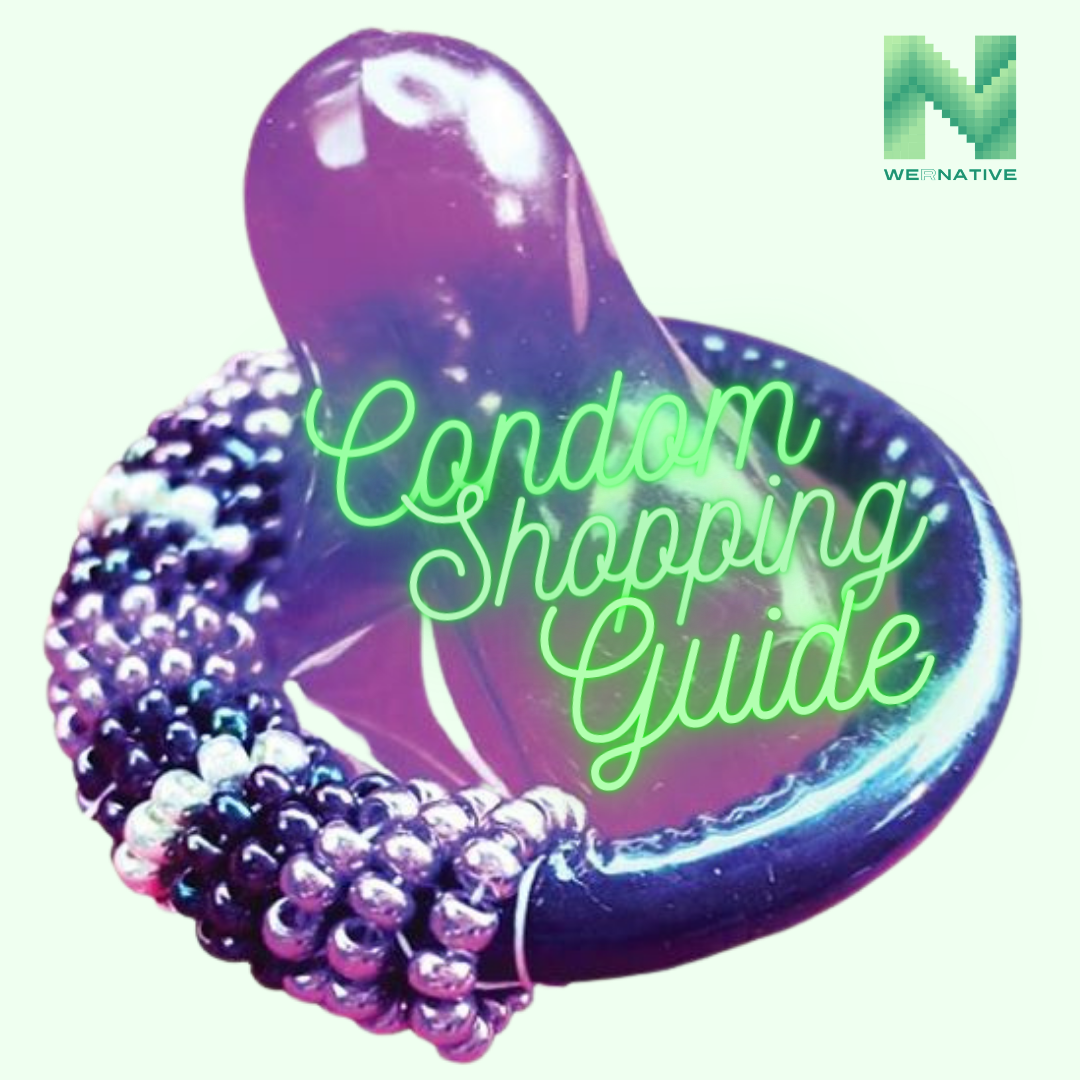4 parts:
- Part 1 = Entering the “Forbidden” Zone
– Walkthrough of entering the store and locating condoms - Part 2 = Products
– Description of various condoms one can expect to find - Part 3 = Smarten Up
– Purchasing - Part 4 = Facts
– Internal (Female) condoms, Dental Dams, and social justice
Intention setting: Please be mindful of the intent of this article and the systemic factors that affect our health. Each individual may differ in their condom shopping experience, and there is not a one size fits all protocol for it. However, it is important to make accurate and safe health info as accessible as possible, so please take care in how you go about this information.
Part 1: Entering the “Forbidden” Zone
Aisle: When you enter the store, head to the health section! Condoms are usually in the family planning, pharmacy, pregnancy, menstrual, and overall health aisles.
Pro-tip: it helps you feel better, grab a hand-basket or cart with several other items to help conceal your purchase ?
Products: Once you find the correct aisles, you should see a variety of sexual and reproductive health products like condoms, lube, spermicide, Plan B, pregnancy tests, etc. Be aware that some of these sexual and reproductive health items may be locked up!
Pause & Breathe: Take your time here and get familiar with what you see so you’ll know what is available and to make future visits easier and quicker!
Also: There are many places to get condoms! Additionally, some health clinics and pharmacies may provide condoms for free so always check first to see the best way for you to access protection.
Part 2: Products
Condom Types (3 main types):
- External (male) condoms
- Internal (female) condoms
- Dental Dams
Common Condom Brands:
- Trojan (external condoms)
- SKYN (external condoms)
- Durex (external condoms)
- Lifestyle (external condoms)
- FC2 (internal condoms)
- Crosstex (dental dams)
- Etc.
Common External Condoms: condoms containing lube, condoms containing spermicide, ribbed condoms, natural condoms, fitted condoms, etc.
There’s a variety of condoms, even some that come in different flavors or with products and textures to elicit sensation! However, some of these may be limited to select stores and sex shops, which are only accessible for those ages 18+
Additionally, at general stores you’ll find packs of condoms rather than individual sets. As a general rule, it’s always a good idea to have more than one for practice or in case of something going wrong.
Internal Condoms: It’s important to know that internal condoms are available, however these are not as widely accessible as external condoms…
For now, please be aware of the significance of internal condoms and reliable sources to access this item – especially budget friendly ones! Some insurance covers the cost of internal condoms and many clinics offer a variety of free condoms, so always check first to see the best way for you to access protection.
Dental Dams: Just like internal condoms, dental dams may be limited in some situations too, so following a similar approach may be helpful. Additionally, you can DIY a dental dam! This is quick & easy to do, with a pair of clean scissors, a new, unused external condom (again, recommend having more than one just in case), and freshly washed hands – check out Auntie ‘Manda’s video on We R Native: https://www.wernative.org/ask-auntie-questions/how-do-you-make-a-dental-dam-using-a-condom
Part 3: Smarten Up
Housekeeping Items:
- Anyone can buy condoms/no ID required (except if you are going to a sex shop, in which you must be 18+ and can be expected to show proof)
- Be aware that at some stores, their sexual & reproductive health products may be locked up, so you may have to ask a store worker for help accessing these items.
- If you do, you may feel emotional about the experience, whether it’s positive, negative, or even neutral/uneventful. That’s ok!
- Whatever happens, try your best to not feel rushed or embarrassed when asking for help and while the helper waits for you to pick out what you want.
- Remember that this is an empowering experience as you are taking your (and others) health seriously, and as a result should be free from stigma, judgement, and shame.
Decision-making Tips:
1. Make sure the product is what you want or need! Asking yourself these questions may help the decision-making process:
A. Is it the right fit?
B. Flavor?
C. Texture?
D. Protection?
Pro-tip: Consider buying different types and more than one, to get an idea of your preferences. Besides, trying something new might add to the fun!
2. Check the expiration date. No matter what.
3. Once you picked out what you want and the product(s) are not expired, it’s time to check out!
Pro-tip: Going through self-checkout can help make the process more private ?
When it comes to buying condoms, whether at a store or asking a healthcare professional for some, the experience may not always be comfortable. As we work towards a better, safer, and healthier future free from colonial stigma and shame, know that it starts with you and you making those decisions about yourself and health. Good job on being a responsible and caring individual ❤️
Resources:
Part 4: Facts
In honor of all things sexy and safe, we wanted to highlight 2 very special condoms deserving of all the attention: The internal (female) condom and dental dams!
Internal (female) condom fun facts:
- Multipurpose! Can be used for vaginal AND anal sex
- Protects against STIs (including HIV) and unwanted pregnancy when used correctly
- Allows more opportunity for people with vaginas to manage their own sexual protection, without relying on partners with penises
- Latex-free (made of nitrile)
- Previously known as “female” condoms – so be aware that some packaging may still use this language
Dental Dam fun facts:
- Use not limited to sexual activities – many dental clinics use these for oral procedures too
- Protects against STIs (including HIV) when used correctly
- Is used for oral sex around the vagina and anus
- One of the few safe sex tools you can DIY (but don’t get too carried away with this – the only safely proven DIY method requires an external condom, as other materials like saran wrap are not tested to protect against STIs, so stick to the book on this one)
- Comes in a variety of flavors and sensations (these specific ones may be limited to select stores and sex shops)
So, what’s the deal about internal condoms and dental dams?
Despite the awesomeness of these products, sexual education is not as expansive, accessible, or present as it should be. So many people are unaware of or able to access these products, in addition to the push for it not being as strong as it is with external condoms. Also, colonial stigma, sexism, transphobia, and homophobia (especially around 2SLGBTQ+ inclusive materials) fuel this issue. Despite internal condoms and dental dams being useful to anyone regardless of gender, the combination of these factors results in an unfortunate outcome of limited use.
This is not only seen on an educational or behavioral level but policy-wise too – FDA regulations also impact the mobility of these products. Currently, there is only one FDA-approved internal condom brand called FC2. Additionally, in 2018 the FDA classified all internal condoms (not just FC2) from class III to class II devices (meanwhile external condoms were already considered class II devices). Since this effect equates internal condoms to the same level as external condoms, this means that the development, manufacturing, and access of the product is officially the same (basically, a lot easier than it has been prior to this).
However, funding, demand, promotion, and attitudes towards internal condoms and dental dams still impact how these effective and evidence-based tools are unequally treated. So, take time today to learn more about these issues and celebrate all the progress that’s been made – safely of course.
Citations:
The Food and Drug Administration (FDA), Obstetrical and Gynecological Devices; Reclassification of Single-Use Female Condom, To Be Renamed Single-Use Internal Condom, 83 Fed. Reg. 48711 (Oct. 29, 2018) [hereinafter FDA 83 Fed. Reg. 48711 (Oct. 29, 2018)].
Ramanarayan, D. (2021). Internal condoms: A tool to advance sexual and reproductive health and rights for all. Change. Retrieved February 8, 2022, from https://srhrforall.org/internal-condoms-a-tool-for-sexual-and-reproductive-health/


